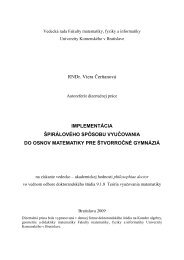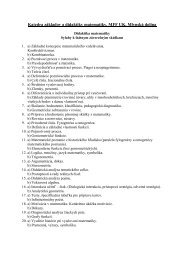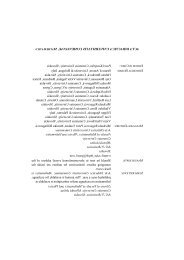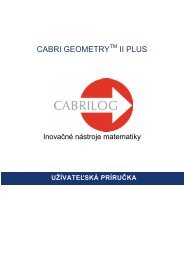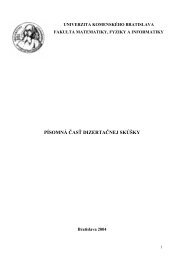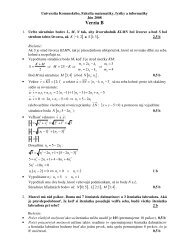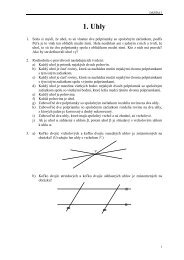vector calculus and solid geometry at teaching of mathematics
vector calculus and solid geometry at teaching of mathematics
vector calculus and solid geometry at teaching of mathematics
You also want an ePaper? Increase the reach of your titles
YUMPU automatically turns print PDFs into web optimized ePapers that Google loves.
Acta Didactica Universit<strong>at</strong>is ComenianaeM<strong>at</strong>hem<strong>at</strong>ics, Issue 6, 2006VECTOR CALCULUS AND SOLID GEOMETRYAT TEACHING OF MATHEMATICSAT SECONDARY SCHOOL 1LUCIA RUMANOVÁAbstract. Paper is present<strong>at</strong>ion analysis <strong>of</strong> problem in the theory <strong>of</strong> didactic situ<strong>at</strong>ion <strong>and</strong>the evalu<strong>at</strong>ion <strong>of</strong> experiment with using st<strong>at</strong>istical program CHIC. Problem analysis istask <strong>of</strong> stereometry for students from secondary schools. Aim <strong>of</strong> experiment was mentionon problems with applic<strong>at</strong>ion <strong>of</strong> knowledge <strong>of</strong> different part <strong>of</strong> m<strong>at</strong>hem<strong>at</strong>ics <strong>at</strong> solution <strong>of</strong>stereometry problem.Résumé. Cet article présente une analyse du problème dans la théorie des situ<strong>at</strong>ionsdidactiques et la conclusion d´une expérience avec l´utilis<strong>at</strong>ion du logiciel CHIC. Le problèmeanalysé est une tâche de la stéréométrie donnée pour les étudiants de l´école secondaire. Le butde l´expérience est indiquer des problèmes de l´applic<strong>at</strong>ion des connaissances des thèmesdifférents m<strong>at</strong>hém<strong>at</strong>iques dans la solution d´un problème stéréométrique.Zusammenfassung. Der Artikel ist eine Vorführung der Analyse eines Problems mittelsder Theorie der didaktischen Situ<strong>at</strong>ionen und des Auswertens mit Nützung des st<strong>at</strong>istischenProgramms CHIC. Das analysierte Problem ist ein Beispiel der darstellenden Geometriefür Studenten der Mittelschulen bestimmt. Ziel des Experiments ist auf Problemeder Applik<strong>at</strong>ion der Kenntnisse von verschiedenen Them<strong>at</strong>ischen Einheiten der M<strong>at</strong>hem<strong>at</strong>ikbeim Lösen eines Beispiels der darstellenden Geometrie zu zeigen.Riassunto. Il presente pone l’analisi di un problema teorico, di una situazione did<strong>at</strong>ticae della valutazione di un esperimento con l’uso del programma st<strong>at</strong>istico CHIC. L’analisidel problema è l’obiettivo di stereometria per studenti della scuola secondaria. Lo scopodell’esperimento è st<strong>at</strong>o quello di s<strong>of</strong>fermarsi su problemi con applicazioni di conoscenzedi diverse parti della m<strong>at</strong>em<strong>at</strong>ica e soluzione di un problema stereometrico.Abstrakt. Článok je ukážkou analýzy problému v teórii didaktických situácií a vyhodnotenieexperimentu s využitím št<strong>at</strong>istického programu CHIC. Analyzovaným problémom jeúloha zo stereometrie určená pre študentov stredných škôl. Cieľom experimentu je poukázať1 This article was partly supported by European Social Funds JPD 3 BA-2005/1-063 <strong>and</strong> SOPLZ-2005/1-225
48L. RUMANOVÁna problémy s aplikovaním vedomostí z rôznych tem<strong>at</strong>ických celkov m<strong>at</strong>em<strong>at</strong>iky pri riešenístereometrickej úlohy.Key words: theory <strong>of</strong> didactic situ<strong>at</strong>ions, analysis a priori, analysis a posteriori, st<strong>at</strong>istical programC.H.I.C., <strong>solid</strong> <strong>geometry</strong>, synthetic <strong>geometry</strong>, <strong>vector</strong> <strong>calculus</strong>, analytic <strong>geometry</strong>1 INTRODUCTIONOne <strong>of</strong> the long – lasting problems in <strong>teaching</strong> m<strong>at</strong>hem<strong>at</strong>ics <strong>at</strong> secondaryschool is the problem <strong>of</strong> rel<strong>at</strong>ions among subjects, respectively the continuity <strong>of</strong>m<strong>at</strong>hem<strong>at</strong>ics content <strong>and</strong> the content <strong>of</strong> other subjects. However, a specific problemis the continuity or the co-ordin<strong>at</strong>ion <strong>of</strong> individual parts <strong>of</strong> m<strong>at</strong>hem<strong>at</strong>ics inthe process <strong>of</strong> educ<strong>at</strong>ion. In this work I want to pay <strong>at</strong>tention to this part <strong>of</strong> <strong>teaching</strong>m<strong>at</strong>hem<strong>at</strong>ics, specifically <strong>geometry</strong> − focus on the rel<strong>at</strong>ion between <strong>solid</strong><strong>geometry</strong> from the <strong>vector</strong> <strong>calculus</strong> point <strong>of</strong> view <strong>and</strong> the synthetic approach to<strong>teaching</strong> <strong>of</strong> <strong>solid</strong> <strong>geometry</strong>.We know th<strong>at</strong> the pupils are taught the basics <strong>of</strong> <strong>vector</strong> algebra <strong>and</strong> analytic<strong>geometry</strong> already in the 8 th or 9 th grade <strong>at</strong> the primary school. L<strong>at</strong>er on they getother inform<strong>at</strong>ion with the notion <strong>of</strong> <strong>vector</strong> <strong>and</strong> its oper<strong>at</strong>ions (sum, odds...) in thefirst grade <strong>at</strong> secondary school, <strong>and</strong> this part is mostly used as a tool for knowledgeanalytic <strong>geometry</strong>, for example equ<strong>at</strong>ions <strong>of</strong> the straight lines, planes, ... <strong>and</strong>l<strong>at</strong>er, for the analytic <strong>geometry</strong> <strong>of</strong> conics, balls, <strong>and</strong> so on.Another problem is little <strong>at</strong>tention paid to applic<strong>at</strong>ion <strong>of</strong> the <strong>vector</strong> <strong>calculus</strong>to solve the tasks <strong>of</strong> <strong>solid</strong> <strong>geometry</strong>. These tasks are taught in other parts onlyby the synthetic <strong>geometry</strong>, as well as little time spent for applic<strong>at</strong>ion tasks inother subjects (physics, geology, geography, etc.). Students usually don’t findrel<strong>at</strong>ive with other subjects <strong>at</strong> solution <strong>of</strong> <strong>solid</strong> problems whereupon their knowledgethey don’t know or don’t tried to apply.2 AIMS OF RESEARCHThe goal <strong>of</strong> research is therefore emphasize problems <strong>of</strong> students <strong>at</strong> secondaryschool with solving <strong>solid</strong> problems, with applic<strong>at</strong>ion their knowledge (from differentpart <strong>of</strong> m<strong>at</strong>hem<strong>at</strong>ic) in <strong>solid</strong> <strong>geometry</strong>, as well as mention problems <strong>of</strong> studentsto find connection between parts <strong>of</strong> m<strong>at</strong>hem<strong>at</strong>ics <strong>and</strong> other learning subjects.Then the aim <strong>of</strong> research is also experimental verify validity <strong>of</strong> the hypothesesH1–H4 <strong>and</strong> eventually suggest solutions <strong>of</strong> effectiveness educ<strong>at</strong>ion <strong>of</strong> analytical(<strong>vector</strong>) <strong>geometry</strong> with rel<strong>at</strong>ing parts <strong>of</strong> m<strong>at</strong>hem<strong>at</strong>ic <strong>and</strong> thereafter enhancementeduc<strong>at</strong>ion between learning subjects <strong>at</strong> secondary school.
VECTOR CALCULUS AND SOLID GEOMETRY AT SECONDARY SCHOOL 49Abovementioned problems we summarized to following hypotheses:H1 The <strong>solid</strong> <strong>geometry</strong> is taught <strong>at</strong> secondary school separ<strong>at</strong>ely, i. e. students aresepar<strong>at</strong>ely taught axiom<strong>at</strong>ic, separ<strong>at</strong>ely deal with synthetic <strong>geometry</strong>, separ<strong>at</strong>elyanalytic <strong>geometry</strong>, <strong>and</strong> so the sequence <strong>of</strong> various approaches is minimal orany.H2 In m<strong>at</strong>hem<strong>at</strong>ics textbook there aren’t examples with unific<strong>at</strong>ion character,which would promote elimin<strong>at</strong>ion limit<strong>at</strong>ions (to fault) listed in H1.H3 Students <strong>of</strong> secondary school with the established educ<strong>at</strong>ional schedule haven’tenough ability to apply their knowledge <strong>of</strong> the <strong>vector</strong> <strong>calculus</strong> in otherareas <strong>of</strong> m<strong>at</strong>hem<strong>at</strong>ics, apart from analytic <strong>geometry</strong>, <strong>and</strong> th<strong>at</strong> in this case onlyformally.H4 Students <strong>of</strong> secondary school are not able in ample measure to be aware <strong>of</strong>the continuity <strong>of</strong> synthetic <strong>and</strong> analytic <strong>geometry</strong> (<strong>vector</strong> <strong>calculus</strong>) in solution<strong>of</strong> particular problem situ<strong>at</strong>ions. Similar situ<strong>at</strong>ion applies to University studentswho will be teachers <strong>of</strong> m<strong>at</strong>hem<strong>at</strong>ics.3 PREPARATION OF THE EXPERIMENTIn accordance with the tenets theory <strong>of</strong> didactic situ<strong>at</strong>ions frame: within theframe <strong>of</strong> the didactic situ<strong>at</strong>ion S 3 (noosferic didactic situ<strong>at</strong>ion) we made an analysis<strong>of</strong> m<strong>at</strong>h textbooks for secondary schools, an analysis <strong>of</strong> various m<strong>at</strong>hem<strong>at</strong>icalm<strong>at</strong>erials, where the goal was to choose a useful problem for students <strong>and</strong> whichwould help us to find out reply to already formul<strong>at</strong>ed hypothesis H1, H2, H3 <strong>and</strong>H4 in the introduction. Our goal was to seek such a problem, which the studentswere not able to solve with the learnt simple algorithms <strong>and</strong> in m<strong>at</strong>h textbookthere usually aren’t these types <strong>of</strong> problems.At last (after different reflections <strong>and</strong> after analysis <strong>of</strong> m<strong>at</strong>h textbooks forsecondary school) we chose problem from French textbook for secondary schoolM<strong>at</strong>hém<strong>at</strong>iques – Geometrie – Première S-E as applic<strong>at</strong>ion examples (M<strong>at</strong>hém<strong>at</strong>iques– Geometrie – Première S-E).The task for the students in this experiment was to try giving an examplefrom the <strong>solid</strong> <strong>geometry</strong> with exploit<strong>at</strong>ion knowledge out <strong>of</strong> analytic <strong>geometry</strong><strong>and</strong> <strong>vector</strong> <strong>calculus</strong>. (Wh<strong>at</strong> we awaited results). Results <strong>of</strong> experiment have mentionproblems with solving <strong>solid</strong> problems, with applic<strong>at</strong>ion their knowledge(from different part <strong>of</strong> m<strong>at</strong>hem<strong>at</strong>ic) in <strong>solid</strong> <strong>geometry</strong>, as well as mention problems<strong>of</strong> students to find connection between parts <strong>of</strong> m<strong>at</strong>hem<strong>at</strong>ics <strong>and</strong> other learningsubjects. Results <strong>of</strong> this experiment had to show how the students could use <strong>at</strong>tainmentsfrom these units.
50L. RUMANOVÁThe task was:Given is a cube ABCDEFGH <strong>and</strong> K-point, L-point, M-point, N-point, soth<strong>at</strong> K-point is centre <strong>of</strong> upper surface EFGH, L-point is centre <strong>of</strong> theAB, M- point belong to AE, where AM = 1 AE <strong>and</strong> N-point belong3to BG BN = 1 BG . Are the points K, L, M, <strong>and</strong> N coplanary?3Based on the above-mentioned criteria the final sentence <strong>of</strong> the given taskcan be interpreted in several different ways, their experimental <strong>at</strong>testing will bethe part <strong>of</strong> our following research <strong>of</strong> this field.Students could solve problem in different theoretical frame with referenceto their level <strong>of</strong> knowledge <strong>and</strong> sciential level <strong>at</strong> secondary school. There arepossible str<strong>at</strong>egy <strong>of</strong> students solution (analyse a priori <strong>of</strong> problem design<strong>at</strong>ion toexperiment) which rel<strong>at</strong>e with some parts <strong>of</strong> m<strong>at</strong>hem<strong>at</strong>ic:Q 1 : Vector <strong>calculus</strong> − exploit<strong>at</strong>ion collinearity <strong>of</strong> <strong>vector</strong>s or coplanarity<strong>of</strong> <strong>vector</strong>sQ 2 : Analytic solution − writing general equ<strong>at</strong>ion <strong>of</strong> plane assigned threefrom four given points <strong>and</strong> then we prove incidence<strong>of</strong> fourth point into planeQ 2´: Analytic solutionQ 2´´: Analytic solution− writing parametric equ<strong>at</strong>ion <strong>of</strong> plane assignedthree from four given points <strong>and</strong> then we proveincidence <strong>of</strong> fourth point into plane− writing parametric equ<strong>at</strong>ions <strong>of</strong> two lines fromgiven fourth points <strong>and</strong> then we fount out theirrel<strong>at</strong>ive position (if they construct <strong>of</strong> plane)Q 3 : Synthetic approach − construction section <strong>of</strong> plane <strong>of</strong> cube <strong>and</strong> then weprove incidence fourth point into planeQ 4 : Vector <strong>calculus</strong> − exploit<strong>at</strong>ion <strong>at</strong>tributes <strong>of</strong> “barycentre“
VECTOR CALCULUS AND SOLID GEOMETRY AT SECONDARY SCHOOL 514 POSSIBLE STRATEGIES OF STUDENTS SOLUTION – ANALYSEA PRIORI OF PROBLEM DESIGNATION TO EXPERIMENTQ 3 : Synthetic approachFigure 1 1. ML ; M ∈ ABF ; L∈ABF ; ML∈ABF 2. P, Q; ML∈ABF ; BF∈ABF ; EF∈ABF P= ML∩BF∧ Q= ML∩EF3. PN ; P ∈ BCG ; N ∈ BCG ; PN ∈ BCG 4. X, Y; PN ∈ BCG ; BC∈BCG;FG∈BCG X = PN ∩BC∧ Y = PN ∩FG5. LX ; L∈ ABC ; X ∈ ABC ; LX ∈ ABC 6. QY ; Q ∈ EFG ; Y ∈ EFG ; QY ∈ EFG 7. Z; EH ∈ EFG ; QY ∈ EFG Z = EH ∩QY 8. MZ ; M ∈ ADH ; Z ∈ ADH ; MZ∈ADH9. MLXYZa) we construct the section plane LMN <strong>of</strong> cube ABCDEFGH <strong>and</strong> thanb) we <strong>at</strong>test: ? K∈ LMN ? (Th<strong>at</strong> they are single calcul<strong>at</strong>ions – for examples:solution with exploit<strong>at</strong>ion follows Figure 2 or exploit<strong>at</strong>ion resemblance betweentriangle).
52L. RUMANOVÁFigure 2Q 2 : Analytic solutionFigure 3This is parametric equ<strong>at</strong>ion <strong>of</strong> plain MLN 1 : x = t31y = t+s21 1z = − s; t, s ∈ R3 3( M , ML , MN )
VECTOR CALCULUS AND SOLID GEOMETRY AT SECONDARY SCHOOL 53⎡1 1 ⎤ And then the question is: K⎢, ,1 ∈ MLN2 2 ⎥ ?⎣ ⎦1 1We solve the system <strong>of</strong> equ<strong>at</strong>ions:2 = 3 t1 1= t+s2 21 11 = − s . 3 3For parametersK∈ MLN .3t = <strong>and</strong> s =− 2 , the equ<strong>at</strong>ions have a solution, there out resulting:2Q 1 : Vector <strong>calculus</strong> (exploit<strong>at</strong>ion collinearity <strong>of</strong> <strong>vector</strong>s or coplanarity)Figure 4 The problem is: Are the <strong>vector</strong>s LS <strong>and</strong> LK collinear? (point S is a centre<strong>of</strong> line segment MN ). If the <strong>vector</strong>s are collinear, so the K-point, L-point, M-point, N-point are coplanar.For the <strong>vector</strong> LS resulting these terms: LS = LB + BN + NS ; 2.LS = LB + LA + BN + AM + NS + MS .By means <strong>of</strong> substitution rel<strong>at</strong>ions <strong>and</strong> simple reforms resulting term: 1 LS = ( BG + AE).6
54L. RUMANOVÁIn like the manner for the <strong>vector</strong> LK ⇒ 1 LK = ( BG + AE).2 1 And from the rel<strong>at</strong>ionship <strong>of</strong> <strong>vector</strong>s LS , LK following: LS = LK <strong>and</strong> so,3 the <strong>vector</strong>s LS <strong>and</strong> LK are collinear.Q 4 : Vector <strong>calculus</strong> – exploit<strong>at</strong>ion “barycentre”Figure 5K-point is a barycentre <strong>of</strong> E(1), G(1), L-point is a barycentre <strong>of</strong> A(2), B(2),M-point is a barycentre <strong>of</strong> A(2), E(1) <strong>and</strong> N-point is a barycentre <strong>of</strong> B(2), G(1).And then, the question is: Wh<strong>at</strong> is barycentre G <strong>of</strong> this points set {A(2),B(2), G(1), E(1)} ?From the facilities <strong>of</strong> barycentre ⇒ G is barycentre <strong>of</strong> {M(3), N(3)} <strong>and</strong>{K(2), L(4)}. 3 2 So, the points K, L, M, N are coplanary, because MG = MN <strong>and</strong> LG = LK .66Analysis a-priori problem had been formul<strong>at</strong>ed <strong>and</strong> teacher’s activityin a-didactic situ<strong>at</strong>ionThe base <strong>of</strong> didactic research is the test students´ reactions in the given didacticsitu<strong>at</strong>ion. So as we could make the test to realize <strong>at</strong> the first we had to dothe full analysis <strong>of</strong> didactic situ<strong>at</strong>ion itself.My working come out from the theory <strong>of</strong> Guy Brousseau, Yves Chevallard,A. Sierpinska, the found<strong>at</strong>ion <strong>of</strong> it is the theory <strong>of</strong> didactic situ<strong>at</strong>ion. The French
VECTOR CALCULUS AND SOLID GEOMETRY AT SECONDARY SCHOOL 55school <strong>of</strong> didactic under leading <strong>of</strong> G. Brousseau processed the theory <strong>of</strong> didacticsitu<strong>at</strong>ion, which is useful to make analysis <strong>of</strong> students´ works.This theory suffers us to analysis the listed problem from the several aspects.And just the analysis <strong>of</strong> problem in the individual levels <strong>of</strong> didactic situ<strong>at</strong>ionforms the basis didactic researches.Part <strong>of</strong> the experiment is the integr<strong>at</strong>ion individual phases <strong>of</strong> the problemsolution to system <strong>of</strong> levels in the analyse didactic situ<strong>at</strong>ion.This is the tablet composition <strong>of</strong> milieu <strong>and</strong> with it associ<strong>at</strong>ed types <strong>of</strong> didacticsitu<strong>at</strong>ions (Margolinas 1994).M 3Constructional milieuM 2Project milieuM 1Didactic milieuE 1Reflective studentP 3Teacher −didacticP 2 Teacher −constructorP 1 Teacher −designerS 3Noosferic situ<strong>at</strong>ionS 2Constructional situ<strong>at</strong>ionS 1Project situ<strong>at</strong>ionM 0Milieu <strong>of</strong> learningM -1Modeling milieuE 0StudentE -1 Cognizantintellect studentP 0TeacherP -1 Teacher −scrut<strong>at</strong>orS 0Didactic situ<strong>at</strong>ionS -1Situ<strong>at</strong>ion <strong>of</strong> learningM -2Objective milieuE -2Active studentS -2Modeling situ<strong>at</strong>ionM -3M<strong>at</strong>erial milieuE -3Objective studentS -3Objective situ<strong>at</strong>ionWe formul<strong>at</strong>ed analysis a-priori problem before students´ solutions (our experiment)<strong>and</strong> analysis includes descending analysis (analysis <strong>of</strong> teacher’s work),ascending analysis (analysis <strong>of</strong> student´s work) <strong>and</strong> we also formul<strong>at</strong>ed analysisa-priori problem for st<strong>at</strong>istical program CHIC.5 ANALYSE OF TEACHER’S WORK (DESCENDING ANALYSIS)S 3 – noosferic situ<strong>at</strong>ion – on this stage we analysis the m<strong>at</strong>h textbook for secondaryschool (2nd or 3rd class), analysis various m<strong>at</strong>hem<strong>at</strong>ical m<strong>at</strong>erials (educ<strong>at</strong>ionalschedule…), specifically study <strong>of</strong> <strong>solid</strong> <strong>geometry</strong>, <strong>vector</strong> algebra <strong>and</strong> analytic<strong>geometry</strong>. We want to choose problem, which the students were not able tosolve with the learnt simple algorithms <strong>and</strong> students can use knowledge fromdifferent parts <strong>of</strong> m<strong>at</strong>hem<strong>at</strong>ics <strong>and</strong> other learning subjects. Finish <strong>of</strong> noosfericsitu<strong>at</strong>ion will be the milieu for the next situ<strong>at</strong>ion.
56L. RUMANOVÁS 2 – constructional situ<strong>at</strong>ion – teacher will try to find examples, th<strong>at</strong> weredefined in noosferic situ<strong>at</strong>ion S 3 <strong>and</strong> on the other side in situ<strong>at</strong>ion S 1 , in whichthey will be able to realize. Goal was to choose a useful problem for studentswhich would help him to find reply to already formul<strong>at</strong>e hypothesis H1, H2, H3<strong>and</strong> H4. They are examples which students can abet in examples solution Q 1 ,Q 2 , Q 2´, Q 2´´, Q 3 a Q 4 .S 1 – project situ<strong>at</strong>ion – in situ<strong>at</strong>ion S 1 , teacher writes a text <strong>of</strong> the example<strong>and</strong> he “projects” his solution. Student is one on teacher’s consciousness. Thisis a situ<strong>at</strong>ion, which involves student’s activity, too. The student can solve problemin a way th<strong>at</strong> he constructs the section plane <strong>of</strong> cube, <strong>and</strong> then he finds outif other point is point <strong>of</strong> plane; or the student solves a problem th<strong>at</strong> he writesparametric equ<strong>at</strong>ion <strong>of</strong> plain <strong>and</strong> he finds out if the fourth point is the point <strong>of</strong> theplane; or he applies exploit<strong>at</strong>ion collinearity <strong>of</strong> <strong>vector</strong>s or coplanarity or exploit<strong>at</strong>ion“barycentre” (but this solution assuming nothing).S 0 – didactic situ<strong>at</strong>ion – in this situ<strong>at</strong>ion we analysis <strong>and</strong> do institutionalis<strong>at</strong>ion<strong>of</strong> the new knowledge <strong>and</strong> we formul<strong>at</strong>e the problem. Teacher takes care <strong>of</strong>designed goals <strong>and</strong> he follows student’s solution, too. It is a situ<strong>at</strong>ion where theanalysis <strong>of</strong> teacher’s work <strong>and</strong> analysis <strong>of</strong> student’s work meet, <strong>and</strong> the didacticsitu<strong>at</strong>ion will be the result <strong>of</strong> the <strong>teaching</strong> process.6 ANALYSE OF STUDENT´S WORK (ASCENDING ANALYSIS)We introduce analysis <strong>of</strong> problem Q 3 (synthetic approach).S -3 – objective situ<strong>at</strong>ion – the student gets acquainted with the problem <strong>and</strong>with the m<strong>at</strong>erial milieu. M<strong>at</strong>erial milieu are a cube ABCDEFGH <strong>and</strong> K, L, M,N – points, cognitive component <strong>of</strong> milieu are knowledge about incidence <strong>of</strong> points,lines, planes, geometrical construction new section <strong>of</strong> body, basis <strong>of</strong> vertical projection,the notions as skew lines, intersecting lines, etc. Social component <strong>of</strong> m<strong>at</strong>erialmilieu is mininal because other help isn´t allowing in our experiment (slef –activity <strong>of</strong> students).S -2 – modelling situ<strong>at</strong>ion – the student solves the problem in milieu S -3 , i. e.he constructs the section plane LMN <strong>of</strong> cube ABCDEFGH (for example). Thestudnet makes use <strong>of</strong> the knowledge from <strong>solid</strong> <strong>geometry</strong>, he works withm<strong>at</strong>erial milieu, he applies visions <strong>and</strong> plot, he makes use <strong>of</strong> known rel<strong>at</strong>ions<strong>and</strong> practices. Work <strong>of</strong> student have just character <strong>of</strong> activity <strong>and</strong> there teacherdon´t interfere with students´ solution. It situ<strong>at</strong>ion without teacher´s help <strong>and</strong>feedback <strong>and</strong> so student must be able to inspect his work <strong>and</strong> solution.S -1 – situ<strong>at</strong>ion <strong>of</strong> learning – in this situ<strong>at</strong>ion the studnet takes the teacher´srole. He solves the formul<strong>at</strong>ed problem by means <strong>of</strong> question: „Are the given pointscoplanar?“, or he verify to validity K∈ LMN . The student abtains inform<strong>at</strong>ion
VECTOR CALCULUS AND SOLID GEOMETRY AT SECONDARY SCHOOL 57from reading text <strong>of</strong> example <strong>and</strong> he formul<strong>at</strong>s his own results. Student loosecharacter <strong>of</strong> activity, he is more thinking <strong>and</strong> formul<strong>at</strong>ing results <strong>of</strong> his work. Theteacher is a scrut<strong>at</strong>or <strong>and</strong> he tries to help, if the student has some absurdity,altern<strong>at</strong>ively if he fails to solve it. In such a case he falls into position S 0 – didacticsitu<strong>at</strong>ion.S 0 – didactic situ<strong>at</strong>ion – in this situ<strong>at</strong>ion the work <strong>of</strong> students is affected bythe teacher <strong>and</strong> takes his advice in form institutionalis<strong>at</strong>ion, which can help tostudent by solving given example, but teacher takes to into consider<strong>at</strong>ion student´ssolution, too. The teacher can help for example with individual elements <strong>of</strong>section cube or with the correct registr<strong>at</strong>ion <strong>of</strong> solving.7 REALIZATION OF THE EXPERIMENT. QUANTITATIVEANALYSIS OF RESULTS RECEIVES FROM EXPERIMENTWITH EXPLOITATION OF STATISTICAL PROGRAM CHICExperiment consisted <strong>of</strong> one <strong>solid</strong> problem <strong>and</strong> was realized in two phases.First particip<strong>at</strong>ed experiment students from different secondary grammar schoolsin Nitra (4 classes, in March 2002)). Second phase experiment was realized in one<strong>of</strong> the secondary grammar schools in Br<strong>at</strong>islava <strong>and</strong> also problem-solved students<strong>at</strong> Faculty <strong>of</strong> m<strong>at</strong>h, physic <strong>and</strong> inform<strong>at</strong>ics in Br<strong>at</strong>islava (in February 2004). Allstudents had repe<strong>at</strong> parts <strong>of</strong> m<strong>at</strong>hem<strong>at</strong>ics needs towards solution <strong>of</strong> our problem.In the aggreg<strong>at</strong>e experiment <strong>at</strong>tended 108 students.On quantit<strong>at</strong>ive analysis <strong>of</strong> results receives from experiment we used st<strong>at</strong>isticalprogram CHIC. In this st<strong>at</strong>istical program were cre<strong>at</strong>ed graphs Similarity tree(Figure 6), Implic<strong>at</strong>ive tree (Figure 7) <strong>and</strong> Implic<strong>at</strong>ive graph (Figure 8).Figure 6
58L. RUMANOVÁFigure 7Figure 861 62 63 64CHIC indic<strong>at</strong>ed the fact th<strong>at</strong> more frequently students´ solution was syntheticapproach <strong>and</strong> on the other side <strong>at</strong> least frequently students´ solution was <strong>vector</strong>solution, which didn’t appear on important level (for results <strong>of</strong> experiment) in thegraphs from CHIC.Analytic solution used 15 students <strong>and</strong> 10 <strong>of</strong> them solved problem with usingsynthetic approach, too. This fact we can read from Implic<strong>at</strong>ive graph althoughconversion between single variables is only 62 %. From graph the Similarity treeto see altogether equality between thereby th<strong>at</strong> students chose analytic solution <strong>of</strong>problem <strong>and</strong> co-ordin<strong>at</strong>e system {altern<strong>at</strong>ively th<strong>at</strong> cock doesn’t fight solve}.Vector solution appeared only in the graph Similarity tree, but not in importantlevel. But there valid<strong>at</strong>ed similarity <strong>of</strong> variables namely student exploit <strong>vector</strong><strong>calculus</strong> <strong>and</strong> student use notion <strong>vector</strong> in solution. Only 2 students solved problem
VECTOR CALCULUS AND SOLID GEOMETRY AT SECONDARY SCHOOL 59with using <strong>vector</strong> approach <strong>and</strong> one <strong>of</strong> them used synthetic <strong>and</strong> analytic approach.Hence <strong>vector</strong> solution didn’t exist in graph Implic<strong>at</strong>ive tree <strong>and</strong> Implic<strong>at</strong>ive graph.No one <strong>of</strong> 108 student didn’t try solve problem with using facilities <strong>of</strong> barycentre<strong>and</strong> so variables <strong>of</strong> barycentre didn’t appeared in no case <strong>of</strong> graphsImplic<strong>at</strong>ive tree, Implic<strong>at</strong>ive graph or Similarity tree. Students usually don’tfind rel<strong>at</strong>ive with other subjects <strong>at</strong> solution <strong>of</strong> <strong>solid</strong> problems whereupon theirknowledge they don’t know or don’t tried to apply. Students don’t find rel<strong>at</strong>ivewith physics <strong>and</strong> m<strong>at</strong>hem<strong>at</strong>ics, although notion barycentre students know fromlessons <strong>of</strong> physics from 1 st class.8 CONCLUSIONProblem <strong>at</strong> <strong>teaching</strong> <strong>solid</strong> <strong>geometry</strong> is sequence single parts <strong>of</strong> m<strong>at</strong>hem<strong>at</strong>icswithin <strong>solid</strong> <strong>geometry</strong>. With this problem rel<strong>at</strong>e too solutions <strong>of</strong> <strong>solid</strong> <strong>geometry</strong>problems. Concrete, students have problem solve problem, students could solveproblem in different theoretical frame with reference to their level <strong>of</strong> knowledge<strong>and</strong> sciential level <strong>at</strong> secondary school, but which the students were not able tosolve problem only with the learnt simple algorithms.The goal <strong>of</strong> research is mention problems with applic<strong>at</strong>ion students´ knowledge<strong>at</strong> solving problem from different part <strong>of</strong> m<strong>at</strong>hem<strong>at</strong>ic in <strong>solid</strong> <strong>geometry</strong> <strong>and</strong>also experimental verify validity or invalidity <strong>of</strong> the hypotheses with using pedagogicalexperiment.One <strong>of</strong> theoretical basis <strong>of</strong> this research was the educ<strong>at</strong>ional schedule. Educ<strong>at</strong>ionalschedule goes through some development on the basis <strong>of</strong> different influences.Our work gives survey <strong>of</strong> this development <strong>and</strong> also changes fromyear 1868 to recent educ<strong>at</strong>ional schedule issued in 1997. We presented the mostimportant changes, concentr<strong>at</strong>ed on educ<strong>at</strong>ional schedule <strong>of</strong> <strong>teaching</strong> <strong>geometry</strong>(<strong>solid</strong> <strong>geometry</strong>) <strong>at</strong> secondary schools.By analysis <strong>of</strong> pedagogical m<strong>at</strong>erials, included educ<strong>at</strong>ional schedule <strong>of</strong>m<strong>at</strong>hem<strong>at</strong>ics for grammar schools we found out th<strong>at</strong> various parts <strong>of</strong> <strong>geometry</strong> insecond <strong>and</strong> third year <strong>of</strong> study are thought isol<strong>at</strong>ed. (There are synthetic <strong>geometry</strong>,<strong>vector</strong> <strong>calculus</strong> <strong>and</strong> analytical <strong>geometry</strong>.) This means th<strong>at</strong> sequence <strong>of</strong> variousways <strong>of</strong> <strong>teaching</strong> <strong>geometry</strong> is minimal. Th<strong>at</strong> verified our hypothesis H1.From analysis <strong>of</strong> educ<strong>at</strong>ional schedule mostly from analysis <strong>of</strong> m<strong>at</strong>hem<strong>at</strong>ics’textbooks for secondary schools came validity <strong>of</strong> st<strong>at</strong>ed hypothesis H2, th<strong>at</strong>means th<strong>at</strong> in m<strong>at</strong>hem<strong>at</strong>ics’ textbooks are very little tasks with unific<strong>at</strong>ion character.Tasks <strong>of</strong> this type could help remove problems st<strong>at</strong>ed in hypothesis H1, inconcrete to find out rel<strong>at</strong>ions between various themes <strong>of</strong> <strong>solid</strong> <strong>geometry</strong> or tohelp by applic<strong>at</strong>ions <strong>of</strong> knowledge <strong>at</strong> solving <strong>of</strong> problem tasks in all them<strong>at</strong>icparts <strong>of</strong> <strong>solid</strong> <strong>geometry</strong>.
60L. RUMANOVÁFrom educ<strong>at</strong>ional schedule came out th<strong>at</strong> there is not enough time for solving<strong>of</strong> such, which can help students to be aware <strong>of</strong> rel<strong>at</strong>ions <strong>of</strong> them<strong>at</strong>ic partsor between different <strong>teaching</strong> subjects. Task given in experiment could havebeen solved with usage <strong>of</strong> mass points’ centre <strong>of</strong> gravity, but no one <strong>of</strong> studentstried to solve tasks with usage <strong>of</strong> knowledge from physics, wh<strong>at</strong> we predicted.Continuance <strong>of</strong> this work should be from th<strong>at</strong> reason also to use mentionedapplic<strong>at</strong>ion’s tasks during <strong>teaching</strong> process, to acquaint students with these tasks<strong>and</strong> to solve them in m<strong>at</strong>hem<strong>at</strong>ics‘ lessons. On approval we put some tasks from<strong>solid</strong> <strong>geometry</strong> with their solutions or with instructions how to solve them intotasks’ collection. This collection can be use <strong>at</strong> <strong>teaching</strong> <strong>of</strong> various parts <strong>of</strong> <strong>solid</strong><strong>geometry</strong>. Tasks can be solved with using <strong>of</strong> planimetry in space or with finding<strong>of</strong> some rel<strong>at</strong>ions between objects in space. We would like also to show, if solving<strong>of</strong> such tasks would improve <strong>teaching</strong> <strong>of</strong> <strong>solid</strong> <strong>geometry</strong>, <strong>and</strong> if students duringsolving <strong>of</strong> tasks would find rel<strong>at</strong>ions between various parts <strong>of</strong> <strong>solid</strong> <strong>geometry</strong>.In experiment took part 108 students. We predicted, th<strong>at</strong> students woulduse mostly synthetic <strong>and</strong> analytic solution <strong>of</strong> tasks, wh<strong>at</strong> showed to be true.Problem didn’t solve 10 students, synthetic solution used 92 students, analyticsolution used 15 students <strong>and</strong> <strong>vector</strong> solutions used 2 students. In experimentwere some students, which wised up to something, th<strong>at</strong> problem having moresolutions. So, 10 students solved problem with 2 methods (analytic <strong>and</strong> synthetic),but only one <strong>of</strong> them solved problem with using 3 methods (analytic,<strong>vector</strong> <strong>and</strong> synthetic). No one <strong>of</strong> 108 students didn’t try to solve problem withusing facilities <strong>of</strong> barycentre.From these facts follow th<strong>at</strong> students didn’t have ability where to appliedknowledge from <strong>vector</strong> <strong>calculus</strong> just <strong>at</strong> analytic <strong>geometry</strong>, for example equ<strong>at</strong>ions<strong>of</strong> the straight lines, planes, ... <strong>and</strong> l<strong>at</strong>er, for the analytic <strong>geometry</strong> <strong>of</strong> conics, balls,<strong>and</strong> so on. And so, in solutions some problem <strong>of</strong> <strong>solid</strong> <strong>geometry</strong> students didn’tapply their knowledge in sufficient measure. Therefore confirmed validity hypothesisH3 <strong>and</strong> H4.Experiment was realized also in university (future teachers <strong>of</strong> m<strong>at</strong>hem<strong>at</strong>ics)<strong>and</strong> confirmed us th<strong>at</strong> there is similar problem with applic<strong>at</strong>ion students´ knowledgefrom different parts <strong>of</strong> m<strong>at</strong>hem<strong>at</strong>ics in <strong>solid</strong> <strong>geometry</strong> <strong>and</strong> also from othersubjects. Whereupon, teacher prefer concrete parts in <strong>teaching</strong> (in lessons <strong>of</strong>m<strong>at</strong>hem<strong>at</strong>ics) <strong>and</strong> so teacher <strong>of</strong>ten disuse examples with unific<strong>at</strong>ion character.Conclusion <strong>of</strong> the work includes collections <strong>of</strong> the tasks <strong>and</strong> we want (<strong>of</strong>course) exp<strong>and</strong> any interesting applic<strong>at</strong>ion problems (tasks) from <strong>solid</strong> <strong>geometry</strong>,which we can improve on lessons <strong>of</strong> m<strong>at</strong>hem<strong>at</strong>ics. Consequently, correction<strong>of</strong> collections <strong>of</strong> these tasks for practical use as part <strong>of</strong> texts in books <strong>of</strong> m<strong>at</strong>hem<strong>at</strong>icsfor secondary schools. In continues <strong>of</strong> experiment we want to try makingeduc<strong>at</strong>ional texts some parts <strong>of</strong> <strong>solid</strong> <strong>geometry</strong>. Educ<strong>at</strong>ional texts will be especiallyorient<strong>at</strong>ed to coordin<strong>at</strong>ion between individual parts <strong>of</strong> <strong>solid</strong> <strong>geometry</strong><strong>and</strong> r<strong>at</strong>her mention rel<strong>at</strong>ions among subjects, i. e. mention possibility to applied
VECTOR CALCULUS AND SOLID GEOMETRY AT SECONDARY SCHOOL 61knowledge from other subjects (especially physics…) <strong>at</strong> <strong>teaching</strong> <strong>of</strong> <strong>solid</strong> <strong>geometry</strong><strong>and</strong> <strong>at</strong> solution <strong>of</strong> problems from <strong>solid</strong> <strong>geometry</strong>.REFERENCESBalacheff N.: Une étude des processus de preures en m<strong>at</strong>hém<strong>at</strong>iques chez des éléves de college, Grenoble,1998Berthelot R.: The role <strong>of</strong> sp<strong>at</strong>ial knowings in the elementary <strong>teaching</strong> <strong>of</strong> <strong>geometry</strong>, Zborník br<strong>at</strong>islavskéhoseminára z teórie vyučovania m<strong>at</strong>em<strong>at</strong>iky, 2001Bereková H., Földesiová L., Hríbiková I., Regecová M., Trenčanský I.: Slovník teórie didaktickýchsituácií, 1. časť, Zborník 4 príspevkov na seminári z teórie vyučovania m<strong>at</strong>em<strong>at</strong>iky,Univerzita Komenského, Br<strong>at</strong>islava, 2001Bereková H., Földesiová L., Regecová M., Kremžárová L., Slávičková M., Trenčanský I., VankúšP., Zámožíková Z.: Slovník teórie didaktických situácií, 2. časť, Zborník 5 príspevkov naseminári z teórie vyučovania m<strong>at</strong>em<strong>at</strong>iky, Univerzita Komenského, Br<strong>at</strong>islava, 2003Brousseau G.: Fondaments et méthods de la didactique des m<strong>at</strong>hém<strong>at</strong>iques, Recherches en Didactiquedes M<strong>at</strong>hém<strong>at</strong>iques, La Pensée sauvage, Grenoble, 1986Brousseau G.: Le contr<strong>at</strong> didactique: le milieu, Recherches en Didactique des M<strong>at</strong>hém<strong>at</strong>iques, vol9/3 pp. 309-336, ed. La Pensée sauvage, Grenoble, 1990Brousseau G.: Theory <strong>of</strong> Didactical Situ<strong>at</strong>ions in M<strong>at</strong>hem<strong>at</strong>ics, Kluwer Academic Publishers, AHDordrecht, The Netherl<strong>and</strong>s, 1997Brousseau G.: Théorie des situ<strong>at</strong>ions didactique, La Pensée sauvage édition, BP 141, Grenoble, 1998Chevallard Y. : La transposition didactique, du savoir savant an savoir enseigné, Grenoble, 1991Chevallard Y.: Concepts foundamentaux de la didactique: perspektives apportées par une approcheantropologique, 1992Dumont A., Grelet, Y., Guillaume, J.-R., M<strong>at</strong>z, C., Plaud, P., Premel, A: M<strong>at</strong>hém<strong>at</strong>iques PremièreS-E – Géométrie. Paris, Magnard, 1991Kupková E.: Analýza problému v teórii didaktických situácií, Zborník br<strong>at</strong>islavského seminára z teórievyučovania m<strong>at</strong>em<strong>at</strong>iky, 2000Regecová M.: L´utilis<strong>at</strong>ion du calcul <strong>vector</strong>iel dans la résolution des exercises de la planimétrieet de la stéréométrie dans l'enseignement secondaire. Quaderni di ricerca in didacticaNo.13, G.R.I.M., http://m<strong>at</strong>h.unipa.it/ /~grim/quaderno13.htm, Palermo 2003, p. 59−75Robert A., L<strong>at</strong>tu<strong>at</strong>i M., Pennincky J.: L´enseignement des m<strong>at</strong>hém<strong>at</strong>iques au lycée, Ellipses, Paris, 1999Sarrazy B.: Le contr<strong>at</strong> didactique, Revue Française de Pédagogie 112, 1995Sierpinská A.: Teória didaktických situácií, www - didactique.image.fr, 2001Spagnolo F.: Insegnare le m<strong>at</strong>em<strong>at</strong>iche nella scuola secondaria, Palermo, 1998Spagnolo F.: La recherche en didactique des m<strong>at</strong>hém<strong>at</strong>iques: un paradigme de référence, Zborníkbr<strong>at</strong>islavského seminára z teórie vyučovania m<strong>at</strong>em<strong>at</strong>iky, 1999Turek I.: Učiteľ a pedagogický výskum, Metodické centrum, Br<strong>at</strong>islava, 1998Trenčanský I.: Hladiny didaktických prostredí a kognitívne funkcie, Zborník br<strong>at</strong>islavskéhoseminára z teórie vyučovania m<strong>at</strong>em<strong>at</strong>iky, 1998Trenčanský I.: Možnosti teórie didaktických situácií na zefektívnenie učenia sa, Zborník br<strong>at</strong>islavskéhoseminára z teórie vyučovania m<strong>at</strong>em<strong>at</strong>iky, 2001LUCIA RUMANOVÁ, Department <strong>of</strong> M<strong>at</strong>hem<strong>at</strong>ics, Faculty <strong>of</strong> Economics <strong>and</strong> Management,Slovak University <strong>of</strong> Agriculture, Tr. A. Hlinku 2, 949 76 Nitra, SlovakiaE-mail: rumanoval@pobox.sk




